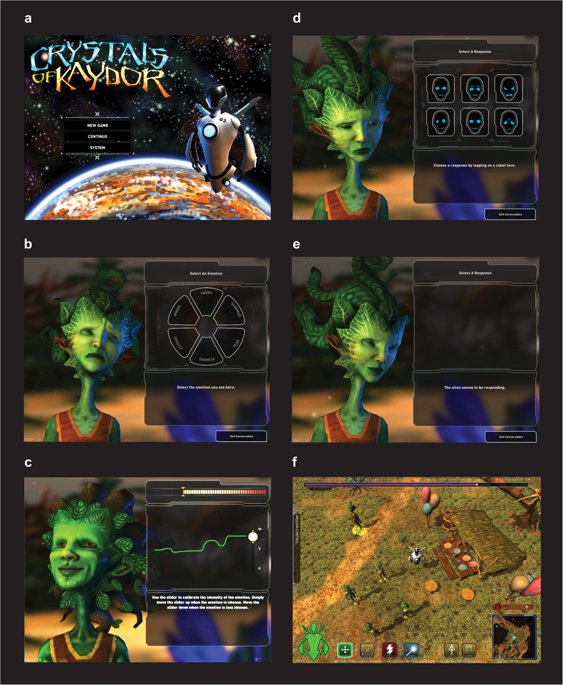npj Science of Learning ( IF 3.6 ) Pub Date : 2018-08-07 , DOI: 10.1038/s41539-018-0029-6 Tammi R. A. Kral , Diane E. Stodola , Rasmus M. Birn , Jeanette A. Mumford , Enrique Solis , Lisa Flook , Elena G. Patsenko , Craig G. Anderson , Constance Steinkuehler , Richard J. Davidson

|
The ability to understand emotional experiences of others, empathy, is a valuable skill for effective social interactions. Various types of training increase empathy in adolescents, but their impact on brain circuits underlying empathy has not been examined. Video games provide a unique medium familiar and engaging to adolescents and can be used to deliver training at scale. We developed an empathy training video game, Crystals of Kaydor (Crystals), and investigated whether playing Crystals increases empathic accuracy (EA) and related brain activation in adolescents (N = 74; 27 female; mean age(sd) = 12.8(0.7) years; age range 11–14 years). Participants completed a resting state functional MRI (rs-fMRI) scan and an EA task during an fMRI scan before and after 2 weeks of daily gameplay with either the empathy training game, Crystals (N = 34), or the commercial video game Bastion (N = 40), an active control condition. There were no group differences in EA improvement following gameplay, however, engagement with training aspects of Crystals was associated with a higher increase in EA-related activation in right temporoparietal junction following gameplay. Moreover, rs-fMRI connectivity in empathy-related brain circuits (posterior cingulate–medial prefrontal cortex; MPFC) was stronger after Crystals gameplay compared to Bastion. The more individuals’ EA increased following Crystals versus Bastion, the stronger their rs-fMRI connectivity in brain circuits relevant for emotion regulation (amygdala-MPFC). These findings suggest that a video game designed to increase empathic accuracy produces behaviorally-relevant, functional neural changes in fewer than 6 h of gameplay in adolescents.
中文翻译:

青少年电子游戏移情训练的神经相关性:一项随机试验
理解他人的情感经历,同理心的能力是进行有效社交互动的一项宝贵技能。各种类型的训练会增加青少年的共情感,但尚未检查其对共情基础脑回路的影响。电子游戏提供了一种独特的媒介,使青少年熟悉并参与其中,并且可以用来进行大规模培训。我们开发了一个移情训练视频游戏,即“凯多水晶(Crystals)”,并研究了玩“水晶”是否会提高青少年的移情准确性(EA)和相关的大脑激活(N = 74; 27女;平均年龄(sd)= 12.8(0.7)岁;年龄范围11-14岁)。参与者在每天玩游戏2周之前和之后,使用移情训练游戏Crystals(N = 34)或商业视频游戏Bastion(),在功能磁共振成像扫描之前和之后完成了静息状态功能性MRI(rs-fMRI)扫描和EA任务。ñ = 40),即主动控制条件。在玩游戏后,EA改善方面没有群体差异,但是,在玩游戏后,参与Crystals训练方面的活动与右侧颞顶rie交界处与EA相关的激活的增加相关。此外,与Bastion相比,Crystals游戏后,与移情相关的大脑回路(后扣带回-前额叶内侧皮层; MPFC)中的rs-fMRI连接性更强。晶体与堡垒相比,个体的EA增加的越多,与情绪调节相关的大脑回路中的rs-fMRI连接性越强(杏仁核-MPFC)。这些发现表明,旨在提高移情准确性的视频游戏在青少年不到6小时的游戏过程中会产生与行为相关的功能性神经变化。










































 京公网安备 11010802027423号
京公网安备 11010802027423号